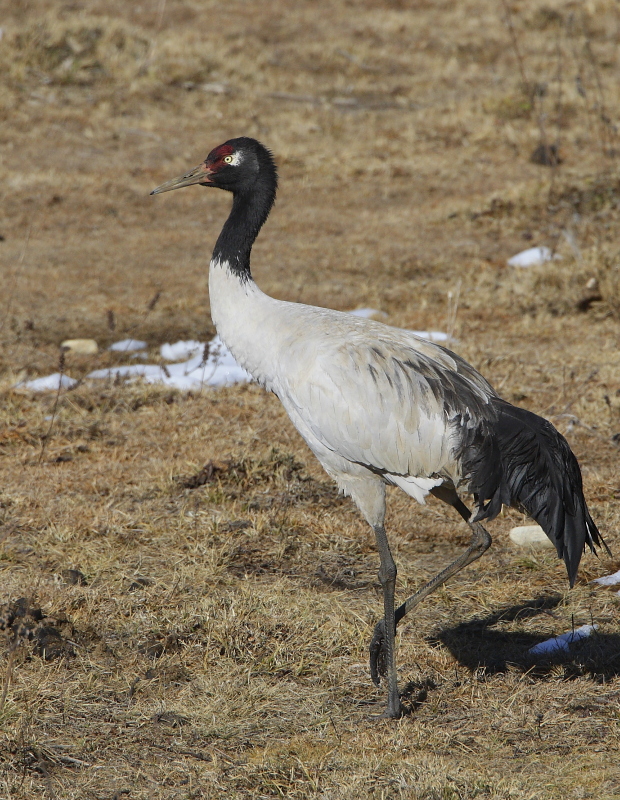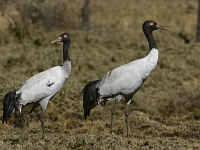Kingdom: Animalia Phylum: Chordata Class: Aves (Birds) Order: Gruiformes Family: Gruidae |
|
Black-necked Crane (Grus nigricollis) summer breeder in Ladakh and winter visitor to Sikkim and Bhutan. The Black-necked Crane was discovered relatively recently in 1876, by a Russian naturalist. Our knowledge of these birds is rather scanty and judging from recent reports their population levels in Tibet and China are higher than previously believed. It is now also learnt that a study-cum-breeding center has been established in the Shanghai province in China. Identification: Large and stately, the inhabitants of open marshlands, wet plains, prairies and occasionally sandy flats, the Black-necked Crane stand 140 cm tall with a wing-spread of seven to eight feet. The black-necked crane has a very pale gray, almost white, body with a black neck, head, feet and well-developed secondaries. Its bill is greenish. Food Habits: A crane eats a great variety and quantity of animal and vegetable matter. Grams, berries, small fruits, tender roots, insects, insect larvae, worms and snails constitute its diet. This the crane supplements with small amphibians, reptiles, birds and mammals but very few fish. In winter some cranes may fly as far as 19 km a day from roost-ponds to grain fields to feed, probing and digging their bills into the soft ground, in search of succulent roots and grubs. They drink by dipping their bills into the water, up to their nostrils, then raising their heads and swallowing quickly. Range: The Black-necked Crane has an exclusive range between the altitudes of 3500 meters to 5500 meters in the tablelands of Central Asia. These Cranes have been recorded from eastern Ladakh, southern Tibet, Bhutan, Arunachal Pradesh to Szechwan, Yunan and Vietnam. There seem to be two distinct populations polarized on either extreme of the Tibetan tableland. The eastern population, which moves along a north-south course, has a clear-cut breeding area in the high altitudes and a wintering area of at least 1000 km, in the lowlands of Vietnam. In contrast, the western population is rather confusing. Breeding and passage areas seem to overlap along a crescent shaped tangent from Ladakh to the lower hills of north-eastern India. The marshes in Ladakh have long been the traditional breeding areas of at least three pairs of black-necked cranes. The cranes arrive in the area in early-May, passing through the Indus valley as the river Indus enter Indian territory, and move along its banks to finally arrive at these marshes. They rest here till about the end of October before moving back to their winter quarters. Nesting: The nest is a large pad of dead aquatic vegetation constructed on treacherous slimy, borax-topped mounds positioned in an open meadow. Both male and female cranes incubate their eggs, sometimes changing roles as often as 10 times a day. The eggs, which normally number two, measure 100 * 60 mm, weigh about 200-210 gm, and are usually a dull-white or brown. They are laid in nests in shallow water up to about 24 inches deep, and take roughly 28-36 days to hatch. 70 % of the eggs hatch successfully into beautiful tawny-brown or gray-chicks that, surprisingly, can swim even when they are only a few hours old. Generally only one of the two chicks survive. Breeding: Crane families remain intact for roughly nine months and it is only when the next breeding season is about to commence that the parents chase their young away. These youngsters join up with others of their age, forming flocks of their own that remain together for the rest of the breeding season. They themselves may start to breed when they are between three to five years old and some rarely, even at the age of two. Threats: Buddhists place a special reverence on these spectacular long-legged birds. It is, therefore, not at all surprising that cranes, which build their nest on open grounds, were once left unharmed by man and welcomed as harbingers of good luck. But now a number of other problems, both natural and man-made face the cranes of Ladakh. High altitude wetland systems, especially those of eastern Ladakh, depend heavily on water derived from melting snows, since the rainfall in this region is virtually non-existent. For the cranes this means, apart from the unavailability of marshland food, the absence of boggy marshes, which deprives them of safe nesting sites.
|
| |
| Apodiformes | Bucerotiformes | Ciconiiformes | Columbiformes | Coraciiformes | Cuculiformes | ||
| Gruiformes | Passeriformes | Piciformes | Psittaciformes | Strigiformes | Trogoniformes | Turniciformes | Upupiformes |


